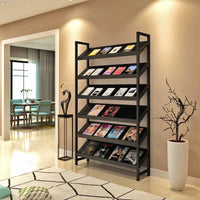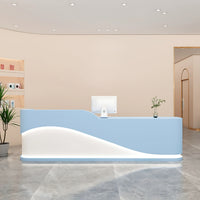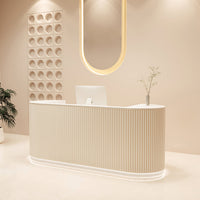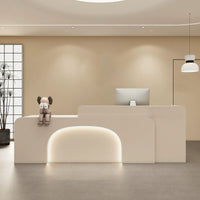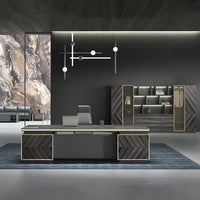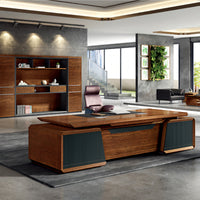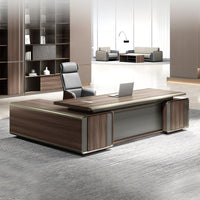Storage Cabinets vs Filing Cabinets: Which Is Right for Your Office?
kaguyasuContent Menu
● Understanding Storage Cabinets and Filing Cabinets
>> What Are Storage Cabinets?
>> What Are Filing Cabinets?
● Key Differences Between Storage Cabinets and Filing Cabinets
● Types of Filing Cabinets and Their Uses
>> Vertical Filing Cabinets
>> Lateral Filing Cabinets
>> Mobile Filing Cabinets
>> Flat File Cabinets
● Types of Storage Cabinets for Offices
>> Metal Storage Cabinets
>> Wooden Storage Cabinets
>> Plastic Storage Cabinets
● Factors to Consider When Choosing Between Storage Cabinets and Filing Cabinets
>> Office Space and Layout
>> Document Volume and Type
>> Accessibility and Workflow
>> Security Needs
>> Durability and Material
>> Future Growth
● Advantages of Filing Cabinets
● Advantages of Storage Cabinets
● When to Choose Filing Cabinets
● When to Choose Storage Cabinets
● Tips for Maintaining Office Storage Efficiency
● Frequently Asked Questions
In today's office environments, efficient storage solutions are essential for maintaining organization, productivity, and a professional appearance. Among the most common storage options are storage cabinets and filing cabinets. While both serve the purpose of organizing office materials, they differ in design, function, and suitability depending on your office needs. This article explores the differences between storage cabinets and filing cabinets, helping you determine which is the best fit for your office setup.

Understanding Storage Cabinets and Filing Cabinets
What Are Storage Cabinets?
Storage cabinets are versatile furniture pieces designed to store a variety of office items such as supplies, equipment, and documents. They come in various sizes, materials, and configurations, often featuring shelves, drawers, or compartments. Storage cabinets are generally used for broader storage needs beyond just paperwork.
What Are Filing Cabinets?
Filing cabinets are specifically designed to organize and store documents. They typically feature drawers optimized for hanging files and are intended to keep paperwork orderly and easily accessible. Filing cabinets come in several types, including vertical, lateral, mobile, and flat file cabinets, each catering to different document storage needs.
Key Differences Between Storage Cabinets and Filing Cabinets
| Feature | Storage Cabinets | Filing Cabinets |
|---|---|---|
| Primary Use | General storage of office supplies, equipment, and documents | Dedicated document filing and organization |
| Drawer Design | May have shelves or drawers; not necessarily optimized for files | Drawers designed for hanging files and document categorization |
| Size and Shape | Varies widely; can be large and bulky or compact | Usually narrower and taller (vertical) or wider and shallower (lateral) |
| Accessibility | Can store diverse items; may require more effort to organize | Easy access to categorized files with labeled drawers |
| Security Features | May have locks for general storage | Often equipped with locks for document security |
| Material Options | Wood, metal, plastic, or composite | Typically metal or wood, designed for durability and fire resistance |
| Space Efficiency | Depends on design; can be bulky | Vertical and lateral options optimize floor space differently |
Types of Filing Cabinets and Their Uses
Vertical Filing Cabinets
Vertical filing cabinets are tall and narrow with deep drawers stacked vertically. They are ideal for offices with limited floor space but require clearance to open the drawers fully. These cabinets are suitable for everyday use in personal workspaces and can securely store a large volume of files in a compact footprint.
Lateral Filing Cabinets
Lateral filing cabinets are wider with shallow drawers that extend side to side. They provide easy access to both legal- and letter-sized documents and are excellent for high-capacity filing needs. Although they take up more horizontal space, they allow for better organization and quicker retrieval of files.
Mobile Filing Cabinets
Mobile filing cabinets are smaller, often vertical, units on casters that fit under desks or workstations. They provide convenient access to frequently used files and can be locked for security. Their mobility makes them flexible for dynamic office layouts.
Flat File Cabinets
Flat file cabinets are designed for large-format documents such as blueprints and artwork. They have wide, shallow drawers that keep documents flat without folding or rolling, preserving their condition.
Types of Storage Cabinets for Offices
Metal Storage Cabinets
Metal storage cabinets are durable, fire-resistant, and often used in offices requiring secure storage. They can withstand heavy use and provide long-term reliability. Metal cabinets are commonly used for storing supplies, tools, or sensitive materials.
Wooden Storage Cabinets
Wooden cabinets offer an elegant appearance and are often chosen for offices emphasizing aesthetics. They may be less durable than metal but add warmth and style to the workspace. Wooden cabinets are suitable for general storage and display.
Plastic Storage Cabinets
Plastic cabinets are lightweight and budget-friendly, ideal for small offices or temporary storage needs. They are less durable and typically used for storing lighter items.
Factors to Consider When Choosing Between Storage Cabinets and Filing Cabinets
Office Space and Layout
Evaluate the available space in your office. Vertical filing cabinets are space-efficient for small areas, while lateral filing cabinets require more horizontal room but offer better file visibility. Storage cabinets vary in size and can be selected to fit awkward or underutilized spaces.
Document Volume and Type
Consider the amount and type of documents you need to store. Filing cabinets are designed for organized paper storage, especially if you handle a large volume of files regularly. Storage cabinets are better suited if you need to store a mix of office supplies, equipment, and documents.
Accessibility and Workflow
If your work requires frequent access to specific files, filing cabinets with labeled drawers provide quick retrieval. Storage cabinets may slow down access if items are stored without a clear system. Mobile filing cabinets can enhance accessibility in dynamic work environments.
Security Needs
For sensitive documents, filing cabinets often come with locking mechanisms to protect confidential information. Storage cabinets can also have locks but may not offer the same level of security features as filing cabinets designed for document protection.
Durability and Material
Metal filing cabinets are highly durable and resistant to wear, making them suitable for high-traffic offices. Wooden storage cabinets add style but may require more care. Plastic options are less durable but economical.
Future Growth
Anticipate your future storage needs. Filing cabinets generally offer higher capacity for document storage and can be supplemented with additional units. Storage cabinets can be chosen modularly to expand as your office grows.
Advantages of Filing Cabinets
- Optimized for Document Organization: Designed specifically to hold hanging files, making document categorization straightforward.
- Space-Efficient Vertical and Lateral Options: Fit different office layouts and storage volumes.
- Security Features: Many models include locks to safeguard sensitive files.
- Durability: Metal filing cabinets resist wear and tear, lasting many years.
- Improved Productivity: Easy access to files reduces time spent searching for documents.
Advantages of Storage Cabinets
- Versatility: Can store a wide range of office items beyond just files.
- Variety of Sizes and Materials: Options to match office decor and specific storage needs.
- Aesthetic Appeal: Wooden cabinets enhance office appearance.
- Flexible Storage: Adjustable shelves and compartments accommodate different items.
- Space Utilization: Can fill awkward spaces and provide additional storage where filing cabinets may not fit.
When to Choose Filing Cabinets
- Your primary need is organized, secure document storage.
- You have a large volume of paperwork requiring systematic filing.
- Office space is limited vertically or horizontally, and you need space-efficient solutions.
- Security of documents is a priority.
- You want to improve document retrieval speed and office workflow.
When to Choose Storage Cabinets
- You need to store a variety of office supplies, equipment, or non-paper items.
- Aesthetic considerations are important for your office environment.
- You require flexible storage options with adjustable shelves.
- Your document storage needs are minimal or supplemented by digital storage.
- You want to maximize storage in unconventional spaces.
Tips for Maintaining Office Storage Efficiency
- Label Everything: Whether using filing or storage cabinets, clear labeling aids quick identification.
- Regularly Purge Unnecessary Items: Keep only essential documents and supplies to avoid clutter.
- Plan for Expansion: Choose modular or expandable units to accommodate growth.
- Consider Ergonomics: Place frequently used items within easy reach.
- Secure Sensitive Materials: Use locking cabinets for confidential files.
Frequently Asked Questions
1. Can filing cabinets store items other than documents?
Yes, while filing cabinets are optimized for document storage, some can hold small office supplies or tools, but they are less versatile than storage cabinets for non-paper items.
2. Are metal filing cabinets better than wooden ones?
Metal filing cabinets are generally more durable, fire-resistant, and secure, making them better for heavy use and sensitive documents. Wooden cabinets offer aesthetic appeal but may lack durability.
3. What size filing cabinet is best for a small office?
Vertical filing cabinets are ideal for small offices due to their narrow footprint, while lateral cabinets require more space but offer greater capacity.
4. How do I decide between a filing cabinet and digital document storage?
Consider the volume of physical documents you must keep, legal requirements, and your workflow. Digital storage reduces physical space but may not replace the need for hard copies in some cases.
5. Can storage cabinets be locked?
Yes, many storage cabinets come with locking options to secure supplies and sensitive items, though their security level may vary compared to filing cabinets designed for confidential documents.
[1] https://aceofficesystems.com/blogs/news/filing-cabinet-vs-file-drawers
[2] https://gradesfixer.com/free-essay-examples/a-file-cabinet-helps-keep-your-home-office-organized/
[3] https://www.flexispot.com/spine-care-center/importance-of-filing-cabinets-in-an-office
[4] https://www.vevor.com/zh-CN/diy-ideas/office-cabinet/
[5] https://www.blue-pencil.ca/document-storage-service-vs-in-house-file-cabinets/
[6] https://www.cnpp.cn/focus/3522544.html
[7] https://www.sauder.com/ideas/everything-you-assumed-about-filing-cabinets-is-wr
[8] https://patents.google.com/patent/CN109463909A/zh
[9] https://www.reddit.com/r/Tools/comments/xpcwdc/file_cabinets_as_toolboxes/
[10] https://www.hujiang.com/ciku/file_cabinet/
Hot Tags: China, Global, OEM, private label, manufacturers, factory, suppliers, manufacturing company



